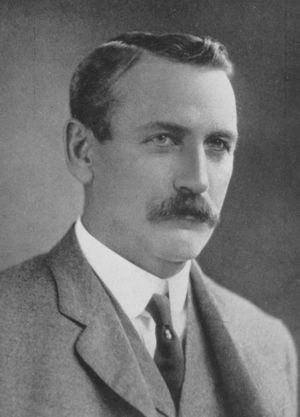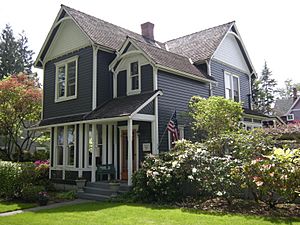John Frank Stevens facts for kids
Quick facts for kids
John Frank Stevens
|
|
|---|---|

Portrait of John Frank Stevens
|
|
| Born | April 25, 1853 West Gardiner, Maine,
United States |
| Died | June 2, 1943 (aged 90) Southern Pines, North Carolina,
United States |
| Nationality | American |
| Alma mater | Western State Normal School, today the University of Maine at Farmington |
| Known for | Great Northern Railway, Panama Canal |
| Awards | John Fritz Medal (1925) Hoover Medal (1938) |
John Frank Stevens (born April 25, 1853 – died June 2, 1943) was an American engineer. He was famous for building parts of the Great Northern Railway across the United States. He also served as the main engineer for the Panama Canal project from 1905 to 1907.
Contents
Early Life and Career
Stevens was born in a small town in Maine. His father was a farmer and a tanner. John went to Maine State Normal School, which is now the University of Maine at Farmington, for two years.
After school in 1873, it was hard to find a job. So, he decided to move west. He started working in the city engineer's office in Minneapolis. For two years, he did many engineering tasks. This included surveying land and helping to build railroads. He learned a lot and became a skilled engineer on his own. In 1878, Stevens married Harriet T. O'Brien. They had five children together.
By 1886, when he was 33, Stevens was a top assistant engineer. He worked for the Duluth, South Shore and Atlantic Railway. He was in charge of building a railway line from Duluth, Minnesota to Sault Ste. Marie, Michigan. This work involved surveying, planning, and building the railway.

Building the Great Northern Railway
In 1889, James J. Hill hired Stevens to work for the Great Northern Railway. Stevens became a "locating engineer." This meant he found the best routes for new railway lines.
Stevens became well-known in 1889. He explored Marias Pass in Montana. He figured out that it was a good place to build a railroad. Stevens was a very good leader and had great ideas. He also found a pass through the Cascade Mountains. This pass is now named Stevens Pass after him. He also helped set up how railroads should be built in northern Minnesota. He oversaw the building of the Oregon Trunk Line too.
In 1895, James J. Hill made Stevens the chief engineer. Later, he became the general manager. During his time at the Great Northern, Stevens helped build over a thousand miles of railway. This included the first Cascade Tunnel.
Leading the Panama Canal Project
Stevens left the Great Northern in 1903. He then worked for the Chicago, Rock Island and Pacific Railroad. In 1905, President Theodore Roosevelt hired him. Stevens became the chief engineer for the Panama Canal project.
Stevens' biggest success in Panama was building all the necessary support systems. He said, "The digging is the least thing of all." He quickly built places to store materials, repair shops, and docks. He also planned and built towns for the workers. These towns had homes, schools, hospitals, churches, and hotels.
He also started big programs to clean up the area and control mosquitoes. These programs helped get rid of yellow fever and other diseases. Stevens saw the canal project as a big railroad problem. He rebuilt the Panama Railway. He also designed a system to use trains to move the huge amounts of soil from the digging sites.
Stevens also argued against building a sea-level canal. This was the type of canal the French had tried to build before. He convinced President Roosevelt that a high-level canal with dams and locks was better.
Leaving the Canal Project
Stevens suddenly resigned from the Canal project in 1907. This made President Roosevelt quite upset. The work was changing from setting up the project to actually building the locks and dams. Stevens was an expert in railroads, not so much in building locks and dams. He likely felt someone else would be better for the next stage of the job. The exact reasons why he left are not fully known.
Later Work
After the Russian Empire collapsed in 1917, the new Russian government asked President Woodrow Wilson for help. They needed help with their transportation systems. Stevens was chosen to lead a group of U.S. railroad experts. They went to Russia to help organize and manage the railway system, including the Trans-Siberian railway.
After the government changed again in Russia, the group's work stopped. Stevens received the Distinguished Service Medal for his help in Russia.
Stevens stayed in Manchuria until 1923. He led a group that managed the Chinese Eastern and Siberian railways. After returning to the United States, Stevens continued to work as an engineering consultant. He retired in the early 1930s. He received the Franklin Institute's Franklin Medal in 1930. He then moved to Southern Pines, North Carolina, where he passed away in 1943 at the age of 90.

